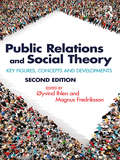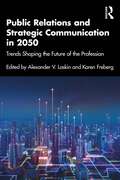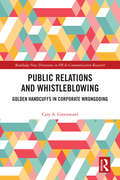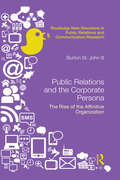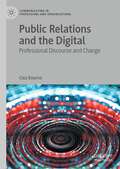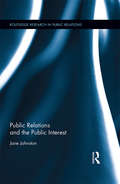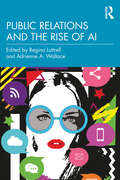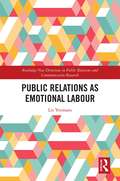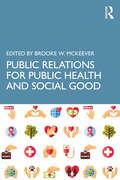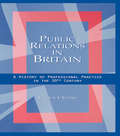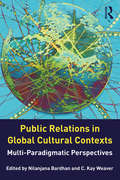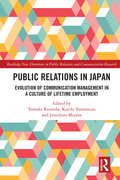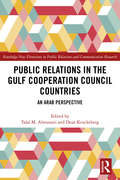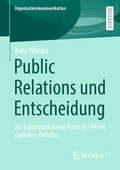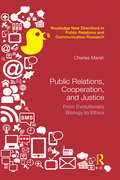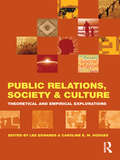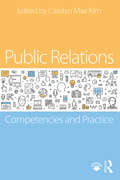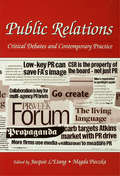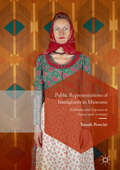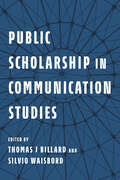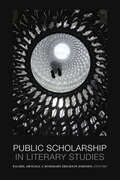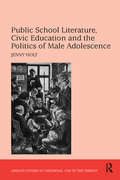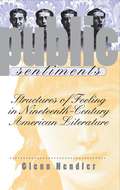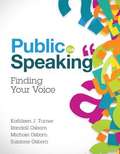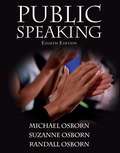- Table View
- List View
Public Relations and Social Theory: Key Figures, Concepts and Developments (Routledge Communication Series)
by Øyvind Ihlen Magnus FredrikssonPublic Relations and Social Theory: Key Figures, Concepts and Developments broadens the theoretical scope of public relations studies by applying the work of a group of prominent social theorists to make sense of the practice. The volume focuses on the work of key social theorists, including Max Weber, Karl Marx, John Dewey, Jürgen Habermas, Niklas Luhmann, Michel Foucault, Ulrich Beck, Pierre Bourdieu, Anthony Giddens, Robert Putnam, Erving Goffman, Peter L. Berger, Gayatri Chakravorty Spivak, Bruno Latour, Dorothy Smith, Zygmunt Bauman, Harrison White, John W. Meyer, Luc Boltanski and Chantal Mouffe. Each chapter is devoted to an individual theorist, providing an overview of that theorist’s key concepts and contributions, and exploring how these can be applied to public relations as a practice. Each chapter also includes a box giving a short and concise presentation of the theorist, along with recommendation of key works and secondary literature.
Public Relations and Strategic Communication in 2050: Trends Shaping the Future of the Profession
by Alexander V. Laskin Karen FrebergTaking stock of the technological, political, economic, and social trends that exist today, this book extends the discussion to analyze and predict how these trends will affect the public relations and strategic communication industry of the future.This book is divided into two sections, the first addressing such key topics as artificial intelligence (AI), big data, political polarization, and misinformation, the second looking at key facets of the profession, such as media relations, crisis communication, and measurement and evaluation. Leading researchers in the discipline share their analysis of these topics while also providing theoretically based and practically relevant insights on how the industry must evolve to keep up with, and perhaps anticipate, changes in culture, society, and technology.This book will be of interest to scholars, industry professionals, and advanced undergraduate and graduate students in public relations and strategic communication.
Public Relations and Whistleblowing: Golden Handcuffs in Corporate Wrongdoing (Routledge New Directions in PR & Communication Research)
by Cary A. GreenwoodThere is a growing interest in corporate whistleblowing, but no comprehensive research has yet focused on public relations practice. Drawing on extensive research on Fortune 1000 and Wilshire 5000 corporations, this book reveals executives’ attitudes and relationships toward their organizations and their impact on whistleblowing. Perhaps unsurprisingly, it reveals that wrongdoing in corporations and the privileges of power coexist. Top-ranking public relations executives, who are mostly white and male, are more likely to be aware of wrongdoing but no more likely to blow the whistle, fundamentally due to their positive relationship with their employers. Using the new lens of evolutionary theory, this study explains whistleblowing, retaliation, and relationships, and in the light of the connection between whistleblowing behavior and executives’ attitudes, it proposes a new theory of the phenomenon of Golden Handcuffs. As public attitudes to corporations, corporate social responsibility (CSR), and transparency harden, these findings have serious implications for companies globally. Researchers, scholars, and advanced students in public relations, organizational communication, corporate communication, strategic communication, corporate reputation, and CSR will find this book full of revealing insights.
Public Relations and the Corporate Persona: The Rise of the Affinitive Organization (Routledge New Directions in PR & Communication Research)
by Burton Saint John IIIFor much of the last century, large, predominantly US corporations used public relations to demonstrate that their missions resonated with dominant societal values. Through the construction and conveyance of the "corporate persona", they aimed to convince citizens that they share common aspirations - and moreover that their corporate "soul" works as a beneficent force in society. Through examining key examples from the last 80 years, this book argues that PR, through the corporate persona, works to create a sense of shared reality between the corporation and the average citizen. This has been instrumental in conveying, across generations, that the corporation is an affinitive corporate persona - a fellow companion in the journey of life. The construct is obviously ripe for manipulation, and the role of PR in creating and promoting the corporate persona in order to align corporations and stakeholders is potentially problematic. From wage inequality to climate change, preserving the corporate status quo may be negative. This original and thought-provoking book not only critically analyses how PR and its role in the corporate persona works to solidify power, but also how that power might be used to further goals shared by the corporation and the individual. Scholars and advanced students of public relations, organizational communications and communication studies will find this book a challenging and illuminating read.
Public Relations and the Digital: Professional Discourse and Change (Communicating in Professions and Organizations)
by Clea BourneThis book takes a people-centred approach to the ever-fluid and rapidly-transforming professional world of public relations (PR) in the age of digital platforms. As everyday PR work becomes increasingly shaped by the platform economy, this is transforming how the PR profession talks about itself, its issues and concerns. Drawing on different textual genres and discursive strategies, the author examines the shifting boundaries between PR and adjacent fields such as advertising, marketing and journalism – and illuminates varied lifeworlds of PR professionals from different backgrounds, races and genders. Written for academics, practitioners and those interested in the world of public relations, the book will also be enjoyed by young professionals working in this interesting and fast-changing occupation.
Public Relations and the Public Interest (Routledge Research in Public Relations)
by Jane JohnstonIn this book, Johnston seeks to put the public interest onto the public relations ‘radar’, arguing the need for its clear articulation into mainstream public relations discourse. This book examines literature from a range of fields and disciplines to develop a clearer understanding of the concept, and then considers this within the theory and practice of public relations. The book’s themes include the role of language and discourse in establishing successful public interest PR and in perpetuating power imbalances; intersections between CSR, governance, law and the public interest; and how activism and social media have invigorated community control of the public interest. Chapters explore the role of the public interest, including cross-cultural and multicultural challenges, community and internal consultation, communication choices and listening to minorities and subaltern publics.
Public Relations and the Rise of AI
by Regina Luttrell Adrienne A. WallaceThis book explores the potential of artificial intelligence (AI) to transform public relations (PR) and offers guidance on maintaining authenticity in this new era of communication.One of the main challenges PR educators, researchers, and practitioners face in the AI era is the potential for miscommunication or unintended consequences of using AI tools. This volume provides insights on how to mitigate these risks and ensure that PR strategies are aligned, offering practical guidance on maintaining trust and authenticity in PR practices. Readers will learn to leverage AI for enhanced communication strategies and real-time audience engagement while navigating the ethical and legal implications of AI in PR. Featuring contributions from leading scholars, the book includes case studies and examples of AI-driven PR practices, showcasing innovative approaches and lessons from well-known brands. It offers a global perspective on AI’s impact on PR, with insights for practitioners and scholars worldwide.This book equips public relations educators, researchers, and professionals with the knowledge and tools they need in the changing landscape of communication in the age of AI.
Public Relations as Emotional Labour: TBC (Routledge New Directions in PR & Communication Research)
by Liz YeomansInextricably linked to neoliberal market economies, public relations’ influence in our promotional culture is profound. Yet many aspects of the professional role are under-researched and poorly understood, including the impact on workers who construct displays of feeling to elicit a desired emotional response, to earn trust and manage clients. The emotionally demanding nature of this aspirational work, and how this is symptomatic of "always on" culture, is particularly overlooked. Drawing on interviews with practitioners and agency directors, together with the author’s personal insights from observations in the field, this book fills a significant gap in knowledge by presenting a critical-interpretive exploration of everyday relational work of account handlers in PR agencies. In underscoring the relationship-driven, highly contingent nature of this work, the author shows that emotional labour is a defining feature of professionalism, even as public relations is reconfigured in the digital age. In doing so, the book draws on a wide range of related contemporary social and cultural theories, as well as critical public relations and feminist public relations literature. Scholars, educators and research students in PR and communications studies will gain rich insights into the emotion management strategies employed by public relations workers in handling professional relationships with clients, journalists and their colleagues, thereby uncovering some of the taken-for-granted aspects of this gendered, promotional work.
Public Relations for Public Health and Social Good
by Brooke W. McKeeverForegrounding the work professional communicators do to support public health and social missions, this book examines how the principles and practices of public relations can be applied by nonprofit, government, and corporate entities working to understand and improve public health and social conditions.Many organizations attempt to influence prosocial behaviors, such as donating one’s time, money, or talents; participating in advocacy or activism; or otherwise working to protect public health or inspire social change. This book explores research and practice related to communication and other factors involved in motivating such efforts. Each chapter focuses on a different topic, providing definitions, summarizing research, and explaining how it has been or can be applied to practice, and ends with discussion questions to consider and references for further reading.Ideally placed for advanced undergraduate and graduate courses in public relations, health communication, or strategic communication as well as for communications professionals looking to apply research to their practice.
Public Relations in Britain: A History of Professional Practice in the Twentieth Century
by Jacquie L'EtangIn this book the author asks a big question: how did public relations develop in Britain and why? The question is answered through a broad ranging narrative which links the evolution of British public relations in the early twentieth century to key political, economic, social, and technological developments. Drawing on oral history interviews and extensive archival research the book highlights some of the sociological issues relevant to a study of public relations and foregrounds the professionalisation of the occupation in the second part of the twentieth century.
Public Relations in Global Cultural Contexts: Multi-paradigmatic Perspectives (Routledge Communication Series)
by Nilanjana Bardhan C. Kay WeaverWhile public relations practice has become increasingly globalized, scholars are still behind in theorizing about the intersections of culture, communication, and power at this level of practice. This volume emphasizes theories and concepts that highlight global interconnectedness through a range of interpretative and critical approaches to understanding the global significance and impacts of public relations. Providing a critical examination of public relations’ contribution to globalization and international power relations, the chapters included here explore alternative paradigms, most notably interpretive and critical perspectives informed by qualitative research. The volume encourages alternative ‘ways of knowing’ that overcome the shortcomings of positivist epistemologies. The editors include multiple paradigmatic approaches for a more complex understanding of the subject matter, making a valuable contribution toward widening the philosophical scope of public relations scholarship. This book will serve well as a core text in classes in international public relations, global public relations, and advanced strategic public relations. Students as well as practitioners of public relations will benefit from reading the perspectives included here.
Public Relations in Japan: Evolution in a Culture of Lifetime Employment (Routledge New Directions in PR & Communication Research)
by Junichiro Miyabe Yamamura Koichi Tomoki KuniedaDespite its rapid economic development, Japan lacks a large public relations industry and its role is viewed very differently from its Western counterparts. PR functions are handled predominantly in-house and a degree in a PR field is not a hiring requirement for those agencies which do operate. Mainstream PR history focusses entirely on its organizational aspects, and there are no Japanese PR "gurus" defining the field.
Public Relations in the Gulf Cooperation Council Countries: An Arab Perspective (Routledge New Directions in PR & Communication Research)
by Dean Kruckeberg Talal M AlmutairiThe Arab world has engaged in public relations for thousands of years, and the public relations literature provides multiple examples extending from ancient times. However, modern public relations is much more vaguely defined. This is partly because the research surrounding public relations practice in the Middle East remains sparse, especially in the Gulf Cooperation Council (GCC) countries. <P><P>This book presents a clear picture of contemporary PR practice in this region, providing a background on the evolution of public relations in each GCC country. It shows how environmental factors (historical, cultural, socio-political, and economic) influence practice in the region. It also contributes to public relations scholarship, education, and practice worldwide by providing new perspectives to those unfamiliar with its practice in this region. <P><P>This book will benefit scholars and practitioners alike through its informed analysis of the strengths and weaknesses of practice in the GCC countries, as well as being of great benefit to the development of professional practice in the region.
Public Relations und Entscheidung: Zur kommunikativen Form der PR im digitalen Zeitalter (Organisationskommunikation)
by Anke OßwaldAnke Oßwald entwickelt in dem vorliegenden Buch eine entscheidungsorientierte Perspektive auf Public Relations. Aufbauend auf einem systemtheoretischen Kommunikationsverständnis konzipiert sie PR als spezifische Entscheidungspraxis und zeigt, welche weitergehenden Erkenntnismöglichkeiten damit verbunden sind. So lassen sich unter anderem Automatisierungsprozesse deutlich differenzierter darstellen und die Folgen für Öffentlichkeit diskutieren. Neue Impulse ergeben sich auch für die Schnittstelle von PR- und Organisationsstudien sowie für die kommunikationswissenschaftlich ausgerichtete Strategieforschung.
Public Relations, Cooperation, and Justice: From Evolutionary Biology to Ethics (Routledge New Directions in PR & Communication Research)
by Charles MarshModern approaches to public relations cluster into three camps along a continuum: conflict-oriented egoism, e.g. forms of contingency theory that focus almost exclusively on the wellbeing of an entity; redressed egoism, e.g. subsidies to redress PR’s egoistic nature; and forms of self-interested cooperation, e.g. fully functioning society theory. Public Relations, Cooperation, and Justice draws upon interdisciplinary research from evolutionary biology, philosophy, and rhetoric to establish that relationships built on cooperation and justice are more productive than those built on conflict and egoistic competition. Just as important, this innovative book shuns normative, utopian appeals, offering instead only empirical, materialistic evidence for its conclusions. This is a powerful, multidisciplinary, and well-documented analysis, including specific strategies for the enactment of PR as a quest for cooperation and justice, which aligns the discipline of public relations with basic human nature. It will be of interest to scholars and advanced students of public relations and communication ethics.
Public Relations, Society & Culture: Theoretical and Empirical Explorations
by Lee Edwards Caroline E. M. HodgesHistorically, public relations research has been dominated by organisational interests, treating the profession as a function to help organisations achieve their goals, and focusing on practice and processes first and foremost. Such research is valuable in addressing how public relations can be used more effectively by organisations and institutions, but has tended to neglect the consequences of the practice on the social world in which those organisations operate. This edited collection adds momentum to the emergent interest in the relationship between public relations, society and culture by bringing together a wide range of alternative theoretical and methodological approaches, including anthropology, storytelling, pragmatism and Latin American studies. The chapters draw on insights from a variety of disciplines including sociology, cultural studies, post-colonialism, political economy, ecological studies, feminism and critical race theory. Empirical contributions illustrate theoretical arguments with narratives and interview extracts from practitioners, resulting in an engaging text that will provide inspiration for scholars and students to explore public relations in new ways. Public Relations, Society and Culture makes an essential contribution to a range of scholarly fields and illustrates the relevance of public relations to matters beyond its organisational function. It will be highly useful to students and scholars of public relations as well as cultural studies, ethnicity/‘race’ communication, media studies, development communication, anthropology, and organisational communication. This insightful book will make a significant contribution to debates about the purpose and practice of public relations in the new century.
Public Relations: Competencies and Practice
by Carolyn Mae KimThe industry of public relations is rapidly evolving, requiring practitioners to have greater specialization than ever before. Hand in hand with the growth of the industry, educational programs have developed to address the growing need for quality preparation for future practitioners. Public Relations: Competencies and Practice focuses on the required competencies expected and applications of public relations into specific sectors of practice. Based on competencies identified by organizations such as the Commission on Public Relations Education and the Public Relations Society of America, Public Relations provides a robust examination of areas such as diversity, leadership, and ethics. The second part of the text focuses on these unique requirements for undergraduate and graduate students focused on entering sectors such as entertainment public relations, nonprofit public relations, or investor relations. The book also features online resources for instructors: Sample course syllabus Discussion questions Suggested midterm and final project Public Relations offers students competency- and practice-focused content from top PR experts and incorporates interviews from professionals in the field to show students how to apply competencies in specific practice sectors.
Public Relations: Critical Debates and Contemporary Practice
by Jacquie L'Etang Magda PieczkaThis new text for students and practitioners in public relations has been built on the acclaimed Critical Perspectives in Public Relations, also edited by Jacquie L'Etang and Magda Pieczka, which is no longer in print. Many of the liveliest minds on the public relations scene have contributed fresh ideas and diverse perspectives: their locatio
Public Representations of Immigrants in Museums
by Yannik PorschéThis book offers an interactionist perspective on theories of public representation, knowledge and immigration in museum institutions. Examining how a Franco-German museum exhibition represents immigrants and exposes public stereotypes, the analysis follows the process of the production and reception of the exhibition as it travelled from Paris to Berlin. The author proposes a microsociological contextualisation analysis integrating discourse analysis and ethnography to compare formats of museum work, social interaction in the exhibition and mass media debates. Visitor reception of the different exhibition versions reveals the symbolic nature of interactions in museums, for example concerning conflicting political voices and accusations of censorship. Depending on the institutional context, interactions in the museums are geared towards securing immigrants a place in national collective memory, towards carrying out debate on integration, or providing opportunities for personal encounters and reflection beyond national categorisation. This book will appeal to students and researchers interested in work on the intersection of sociology, cultural studies, and discursive psychology, in methods of discourse analysis and ethnography; and to practitioners working in museums.
Public Scholarship in Communication Studies
by Larry Gross Silvio Waisbord Chad Raphael Sue Robinson Aymar Jean Christian Holley Wilkin Amy Jordan Susan Mancino Daniel Kreiss Srividya Ramasubramanian Paula Gardner Philip M Napoli Thomas J. Billard Rachel Kuo Yidong Wang Elaine Almeida Stacey L Connaughton Shannon C McGregor Danielle K Brown Todd P Newman Becca BeetsPrometheus brought the gift of enlightenment to humanity and suffered for his benevolence. This collection takes on scholars’ Promethean view of themselves as selfless bringers of light and instead offers a new vision of public scholarship as service to society. Thomas J Billard and Silvio Waisbord curate essays from a wide range of specialties within the study of communication. Aimed at scholars and students alike, the contributors use approaches from critical meditations to case studies to how-to guides as they explore the possibilities of seeing shared knowledge not as a gift to be granted but as an imperative urging readers to address the problems of the world. Throughout the volume, the works show that a pivot to ideas of scholarship as public service is already underway in corners of communication studies across the country. Visionary and provocative, Public Scholarship in Communication Studies proposes a needed reconsideration of knowledge and a roadmap to its integration with community. Contributors: Elaine Almeida, Becca Beets, Thomas J Billard, Danielle K. Brown, Aymar Jean Christian, Stacey L. Connaughton, Paula Gardner, Larry Gross, Amy Jordan, Daniel Kreiss, Rachel Kuo, Susan Mancino, Shannon C. McGregor, Philip M. Napoli, Todd P. Newman, Srividya Ramasubramanian, Chad Raphael, Sue Robinson, Silvio Waisbord, Yidong Wang, and Holley Wilkin
Public Scholarship in Literary Studies
by Rachel Arteaga Rosemary Erickson JohnsenPublic Scholarship in Literary Studies demonstrates that literary criticism has the potential not only to explain, but to actively change our terms of engagement with current realities. Rachel Arteaga and Rosemary Johnsen bring together accomplished public scholars who make significant contributions to literary scholarship, teaching, and the public good. The volume begins with essays by scholars who write regularly for large public audiences in primarily digital venues, then moves to accounts of research-based teaching and engagement in public contexts, and finally turns to important new models for cross-institutional partnerships and campus-community engagement. Grounded in scholarship and written in an accessible style, Public Scholarship in Literary Studies will appeal to scholars in and outside the academy, students, and those interested in the public humanities. "There are books of literary criticism that attempt to reach crossover audiences but none that take this particular public-humanities-focused-on-literary criticism perspective."—Kathryn Temple, Georgetown University Contributions by Rachel Arteaga, Christine Chaney, Jim Cocola, Daniel Coleman, Christopher Douglas, Gary Handwerk, Cynthia L. Haven, Rosemary Erickson Johnsen, Anu Taranath, Carmaletta M. Williams, and Lorraine York.
Public School Literature, Civic Education and the Politics of Male Adolescence (Studies in Childhood, 1700 to the Present)
by Jenny HoltDuring the nineteenth and early twentieth centuries, British society gradually began to see 'adolescence' as a distinct social entity worthy of concentrated study and debate. Jenny Holt argues that the social construction of the public schoolboy, a figure made ubiquitous by a huge body of fictional, biographical, and journalistic work, had a disproportionate role to play in the development of social perceptions of adolescence and in forming ideas of how young people should be educated to become citizens in an age of increasing democracy. With attention to an admirably wide range of popular books as well as examples from the periodical press, Jenny Holt begins with a discussion of the ideas of late-eighteenth-century social radicals, and ends with the First World War, when the more 'serious' public school literature, which sought to involve juvenile readers in complex social and political issues, declined suddenly in popularity. Along the way, Jenny Holt considers the influence of Victorian Evangelical thought, Social Darwinism, and the early-twentieth-century National Efficiency movement on concepts of adolescence. Whether it is shedding new light on well-known texts by Thomas Hughes and Rudyard Kipling, providing a fascinating discussion of works written by boys themselves, or supplying historical context for the development of the concept of adolescence, this book will engage not only scholars of childhood and children's literature but Victorianists and those interested in the history of educational practice.
Public Sentiments
by Glenn HendlerIn this book, Glenn Hendler explores what he calls the "logic of sympathy" in novels by Walt Whitman, Louisa May Alcott, T. S. Arthur, Martin Delany, Horatio Alger, Fanny Fern, Nathaniel Parker Willis, Henry James, Mark Twain, and William Dean Howells. For these nineteenth-century writers, he argues, sympathetic identification was not strictly an individual, feminizing, and private feeling but the quintessentially public sentiment--a transformative emotion with the power to shape social institutions and political movements.Uniting current scholarship on gender in nineteenth-century American culture with historical and theoretical debates on the definition of the public sphere in the period, Hendler shows how novels taught diverse readers to "feel right," to experience their identities as male or female, black or white, middle or working class, through a sentimental, emotionally based structure of feeling. He links novels with such wide-ranging cultural and political discourses as the temperance movement, feminism, and black nationalism. Public Sentiments demonstrates that, whether published for commercial reasons or for higher moral and aesthetic purposes, the nineteenth-century American novel was conceived of as a public instrument designed to play in a sentimental key.
Public Speaking
by Michael Osborn Suzanne Osborn Randall Osborn Kathleen J. TurnerPublic Speaking: Finding Your Voice helps students develop into effective speakers while emphasizing the ethical significance of public speaking and its importance in our increasingly diverse society. The text guides students to become better, more thoughtful consumers as well as producers of messages--all the more important in an age when we are daily bombarded with “fake news” and other forms of deceptive communication. The 11th Edition includes fully updated examples as well as revised learning outcomes that help keep students on track in the course.
Public Speaking (8th edition)
by Michael Osborn Suzanne Osborn Randall OsbornCentered around three core objectives helping readers develop vital communication skills, encouraging speaker adaptability to diverse audiences, and sensitizing speakers to the ethical impact of their words Public Speaking offers both practical advice and an understanding of why such advice works.The eighth edition concentrates on greater simplicity, clarity, and accessibility. The book offers a functional approach to informative speaking and emphasizes the ethics of persuasive speaking. These ideas come to life through examples from real, student, and professional speeches, Exploration and Application exercises at the end of each chapter, and a variety of boxed features throughout the book.
